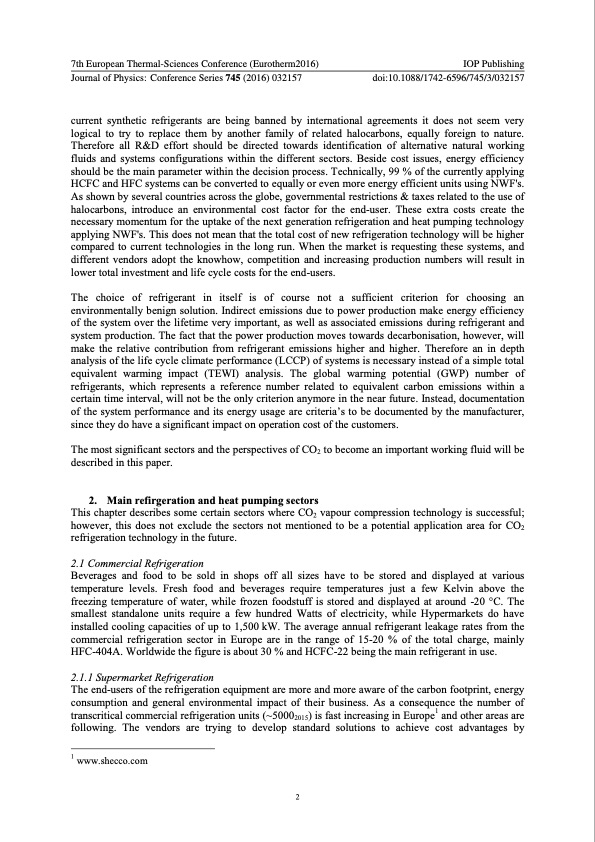
PDF Publication Title:
Text from PDF Page: 003
7th European Thermal-Sciences Conference (Eurotherm2016) IOP Publishing Journal of Physics: Conference Series 745 (2016) 032157 doi:10.1088/1742-6596/745/3/032157 current synthetic refrigerants are being banned by international agreements it does not seem very logical to try to replace them by another family of related halocarbons, equally foreign to nature. Therefore all R&D effort should be directed towards identification of alternative natural working fluids and systems configurations within the different sectors. Beside cost issues, energy efficiency should be the main parameter within the decision process. Technically, 99 % of the currently applying HCFC and HFC systems can be converted to equally or even more energy efficient units using NWF's. As shown by several countries across the globe, governmental restrictions & taxes related to the use of halocarbons, introduce an environmental cost factor for the end-user. These extra costs create the necessary momentum for the uptake of the next generation refrigeration and heat pumping technology applying NWF's. This does not mean that the total cost of new refrigeration technology will be higher compared to current technologies in the long run. When the market is requesting these systems, and different vendors adopt the knowhow, competition and increasing production numbers will result in lower total investment and life cycle costs for the end-users. The choice of refrigerant in itself is of course not a sufficient criterion for choosing an environmentally benign solution. Indirect emissions due to power production make energy efficiency of the system over the lifetime very important, as well as associated emissions during refrigerant and system production. The fact that the power production moves towards decarbonisation, however, will make the relative contribution from refrigerant emissions higher and higher. Therefore an in depth analysis of the life cycle climate performance (LCCP) of systems is necessary instead of a simple total equivalent warming impact (TEWI) analysis. The global warming potential (GWP) number of refrigerants, which represents a reference number related to equivalent carbon emissions within a certain time interval, will not be the only criterion anymore in the near future. Instead, documentation of the system performance and its energy usage are criteria’s to be documented by the manufacturer, since they do have a significant impact on operation cost of the customers. The most significant sectors and the perspectives of CO2 to become an important working fluid will be described in this paper. 2. Main refirgeration and heat pumping sectors This chapter describes some certain sectors where CO2 vapour compression technology is successful; however, this does not exclude the sectors not mentioned to be a potential application area for CO2 refrigeration technology in the future. 2.1 Commercial Refrigeration Beverages and food to be sold in shops off all sizes have to be stored and displayed at various temperature levels. Fresh food and beverages require temperatures just a few Kelvin above the freezing temperature of water, while frozen foodstuff is stored and displayed at around -20 °C. The smallest standalone units require a few hundred Watts of electricity, while Hypermarkets do have installed cooling capacities of up to 1,500 kW. The average annual refrigerant leakage rates from the commercial refrigeration sector in Europe are in the range of 15-20 % of the total charge, mainly HFC-404A. Worldwide the figure is about 30 % and HCFC-22 being the main refrigerant in use. 2.1.1 Supermarket Refrigeration The end-users of the refrigeration equipment are more and more aware of the carbon footprint, energy consumption and general environmental impact of their business. As a consequence the number of transcritical commercial refrigeration units (~50002015) is fast increasing in Europe1 and other areas are following. The vendors are trying to develop standard solutions to achieve cost advantages by 1 www.shecco.com 2PDF Image | R744 ejector technology

PDF Search Title:
R744 ejector technologyOriginal File Name Searched:
Hafner_2016-745_032157.pdfDIY PDF Search: Google It | Yahoo | Bing
CO2 Organic Rankine Cycle Experimenter Platform The supercritical CO2 phase change system is both a heat pump and organic rankine cycle which can be used for those purposes and as a supercritical extractor for advanced subcritical and supercritical extraction technology. Uses include producing nanoparticles, precious metal CO2 extraction, lithium battery recycling, and other applications... More Info
Heat Pumps CO2 ORC Heat Pump System Platform More Info
| CONTACT TEL: 608-238-6001 Email: greg@infinityturbine.com | RSS | AMP |